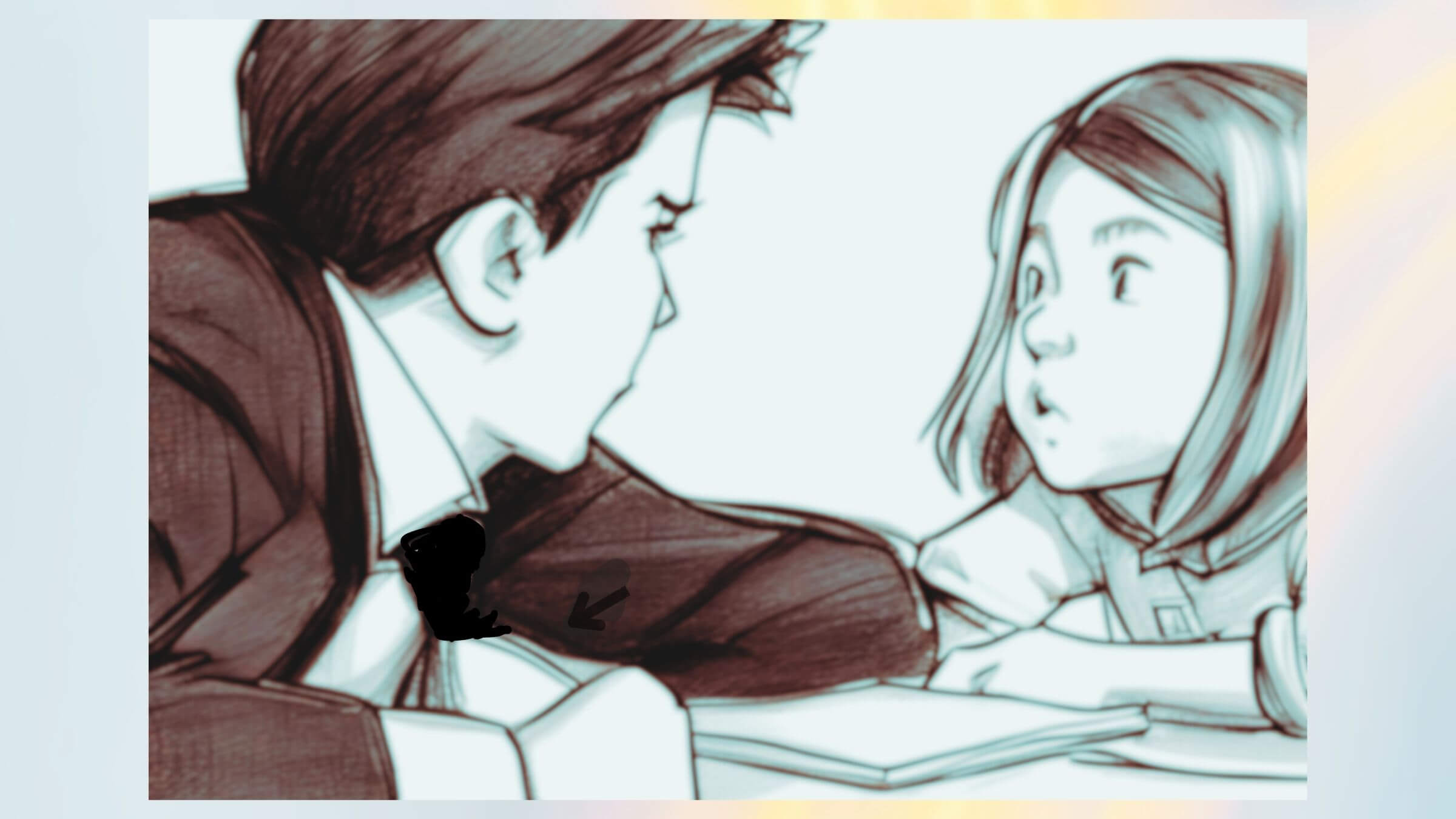BINTEL BRIEFMy kid’s being bullied, antisemitism is involved and the school won’t help. What do I do?
Bintel says there’s nothing worse than feeling like you can’t protect your child. But don’t despair — we’ve got lots of advice

What’s a mom to do when her kid’s being bullied and the school won’t help? Bintel has some advice. (Illustration by Beth Harpaz/Canva)
The Forward has been solving reader dilemmas since 1906 in A Bintel Brief, Yiddish for a bundle of letters. Send us your quandaries about Jewish life, love, family, friends or work via email, Twitter or this form.
Dear Bintel,
My family and I moved to the Bible Belt because of my spouse’s job. Our daughter, who is in elementary school, has faced severe bullying, and some of it is antisemitic and physical. My daughter has become traumatized. I’ve complained for the whole school year but the bullying continues. How do you deal with this? (By the way, at our local shul, we aren’t the only family in this school district to face antisemitism when it comes to our children.)
Signed,
Desperate Mom
Dear Desperate:
There’s nothing worse as a parent than feeling like you can’t protect your kid.
The good news is, there’s a lot you can do to make this situation better. Some of these ideas may be more in your comfort zone than others, but I hope one or more will feel doable.
First, talk to your daughter. Make sure she knows bullying is never OK and it’s not her fault. Kids targeted by bullies often feel alone in their suffering and think they brought the bullying on themselves. Teach her these quick responses that can help disarm a bully: “Whatever!” “Why are you talking to me?” and “Let’s move on!” — and then tell her to walk away.
Then bring in the village. If other families in your shul are experiencing this, organize an evening Zoom meeting or parent meet-up when the kids are in Sunday school. Take stock: How many families are dealing with this? Is it happening in one class or grade, school-wide or district-wide? One bully or many? How many parents have complained to no avail?
Now schedule a meeting with parents and your rabbi, and tell the rabbi about the scope of the problem. Ask the rabbi to accompany a few parents to meet with the principal and head of the school board. Perhaps the rabbi can mobilize other Jewish leaders in the community, or even tap into an interfaith network of other religious leaders willing to lend support. There’s power in unity and numbers.
The meeting at school does not have to be confrontational (although for sure, if there’s a lawyer in the shul who’s willing to come along as an observer, it couldn’t hurt). Focus on the goal: keeping kids safe. This is not necessarily about punishing the perpetrator; it’s about asking school officials to create a respectful community where nobody is being tormented.
Next: The Anti-Defamation League wants to hear from you and anyone else experiencing antisemitism. Please, file an incident report through their website. I know that sounds bureaucratic, but their nearest regional office will follow up with you ASAP. They have lots of experience and tried-and-true approaches to responding to these situations.
“Oftentimes we find the school administration just doesn’t know how to handle something like this,” ADL’s Emily Snider told me when I shared your problem. “They’re in over their heads. They don’t have the resources.”
But ADL does have the resources: a free, comprehensive “No Place for Hate” curriculum that the organization is happy to help schools implement. More than 1,800 schools participate in the “No Place for Hate” program — including in politically conservative states where legal limits have been placed on what educators may say about race and gender. And while the ADL may be able to intervene directly on your behalf with the school, they’re also happy to keep your complaint anonymous.
But Snider acknowledged that while “you can do everything humanly possible” to get the school to take action, in the end, officials might do nothing. That’s why the ADL also offers resources for parents, including books geared for kids, to help parents empower kids to cope with bullying and antisemitism.
Let me share three personal stories about bullying, each with a different takeaway.
When I was in fifth grade, a boy stabbed me in the arm with a sharp pencil. (Good thing kids didn’t have guns in those days!) I went crying to the teacher, who told me to punch him in the arm as hard as I could. I did, and he never bothered me again.
I tell this story not because I think it’s the way to go, but because you’re likely to hear someone advise your kid to fight back. But what kind of a lesson does that teach? That the best way to handle violence is with violence? That only those strong enough to punch back get to live bully-free? Fighting back could also intensify the bullying, and land your child in heaps of trouble.
Second story: A kid I knew in a fancy private school was being tormented by a bully, and the school refused to act. So the parents literally wired the kid. They went to a tech store, bought easily concealed recording equipment, and taught the kid how to use it. The kid caught the bully’s threats and hateful speech on tape. Presented with evidence, the school kicked the bully out. The parents changed schools anyway, but felt they’d achieved a small victory.
Bullies, this story shows, tend to act when adults are nowhere to be found. If you feel your child won’t be believed without evidence, maybe a cellphone can help capture what’s happening.
Last story: Years ago, a child in my care was being bullied. I found myself transformed with rage. I chased that bully down and when he slipped into a store to get away from me, I cornered him in a narrow aisle with a baby stroller. I told him if he ever came near that kid again, I would tell his mother, and the principal, and I’d make his life so miserable that he’d wish he’d never been born. The bully steered clear after that.
Looking back, I’m not proud of what I did, and I don’t recommend you follow my example. In this day and age, an adult who threatens a child might well get sued, arrested or worse. And really, should an adult ever threaten a child? It’s just modeling bullying. I later learned that the bully I confronted was in serious need of help himself — as I suspect many bullies are. I regret that I failed to alert caring adults (his parents, teacher and school guidance counselor) who might have intervened to help him.
Where does all this leave you? If I were in your shoes today, here’s what I’d do. I’d reach out to other parents and your rabbi; I’d file an incident report with the ADL and look at their resources; and I’d speak to a caring adult in the bully’s life.
But I’d also try to empower my child — and not just for the moment when a bully strikes. Research shows that kids who have strong peer groups are less likely to be bullied. Does your daughter have besties she can hang out with at lunch, recess and after school? If not, can you help her find friends through playdates, clubs or teams? Look for positive Jewish spaces where her identity can be affirmed: My temple had a Rosh Chodesh group for adolescent girls, and while Jewish summer camp would be ideal, taking turns hosting a kids’ activity group with parents from your shul works too.
I also believe that we have to teach our kids — especially girls, and maybe, especially Jewish kids? — how to unlock their strength and resilience, both physical and emotional. I used to coach my kids when they were frightened to imagine themselves as lions, make themselves as large as they could, and literally roar! Feed your child stories about underdogs, outliers and strong girls. Depending on her age, consider My Name is Malala, A Wrinkle in Time or Chrysanthemum. Ferdinand is about a bull who wants to pick flowers instead of being macho; The Sneetches and Other Stories was Dr. Seuss’ response to antisemitism. And don’t forget David and Goliath!
One final idea: Might your child be willing to try martial arts? One of my kids loved the discipline and structure of karate, while a friend’s son’s youthful interest in Krav Maga led him to become a world-ranked jiu-jitsu champ! It’s not that we expect your girl to flip that bully on his back, but she might enjoy the classes and they could help build confidence. A little swagger can go a long way. Not always, but sometimes, bullies are the biggest cowards around, and if you stand up to them, they might just disappear.
Signed,
Bintel
Do you have an opinion about this Bintel, or a question of your own? We’d love to hear from you. Email [email protected].























